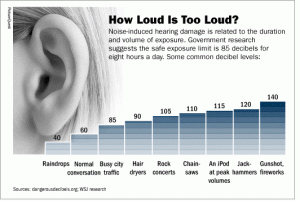Work
Noise, or unwanted sound, is one of the most prevalent occupational health problems. Noise-induced hearing loss (NIHL) is permanent damage to the tiny hair cells in your ears, which are responsible for sending sounds to the brain. Hair cells are not replaceable and once damaged they are unable to generate electrical signals to the brain, causing hearing impairment. Both intense but short noises, a gunshot, or continuous exposure to loud noises, like operating construction equipment, can cause hair cell damage. Noise-induced hearing loss can be temporary and can become gradually permanent if preventative steps are not taken to protect your ears. Short duration of noise exposure is temporary when hearing returns to normal following a resting period. Prolonged exposure to high levels of noise repeatedly over time will gradually turn the temporary loss into permanent hearing loss. OSHA (Occupational Health and Safety Administration) regulates hearing conservation programs to protect workers from significant hearing impairment and the hazards of high noise levels from occupational noise exposure such as factories, railroad, military, mining, and construction/carpentry to name a few. Education and awareness are necessary as not all occupations are covered under the OSHA amendment. Noise-induced hearing loss is preventable.

Any sound above about 85 decibels can lead to hearing loss dependent upon the length of exposure. Employers are required to monitor noise exposure levels if employees are exposed to more than 85 dB over an average of 8 working hours determined through a noise exposure assessment. Area noise measurements are collected to determine implementation and strategies for a hearing conservation program. Audiometric testing is used to assess individuals’ hearing thresholds and effectiveness of the conservation program. Baseline audiograms, annual audiograms, training, and referral to a medical professional are included at no cost to the employee. Annual audiograms are essential to the employees hearing health to catch a Standard threshold shift (STS). An STS is an average shift in either ear of 10 dB or more at 2,000, 3,000, and 4,000 Hz.

An employer is required to provide hearing protection devices (HPDs) to all workers subjected to 8-hour noise levels of 85 dB or more. There are many types of HPDs available, and the employer is required to provide one type of hearing plug and one type of hearing muff. In some extremely loud instances, it may be best to wear both the hearing plug as well as the hearing muff. Hearing protection can reduce unwanted noise to a safe level.
Aside from damaging hearing, loud noise exposure and NIHL can lead to:
Stress
Anxiety
Insomnia, even after noise stops
High blood pressure
Increased heart rate
Isolation due to hearing loss
Depression due to hearing loss
Hobbies
Some recreational hobbies are dangerously loud and can lead to a permanent NIHL including shooting at gun ranges, hunting, personal earbuds, woodworking, sporting events, motorcycles, home improvement, and fireworks to name a few.
Some examples of dangerously loud recreational activities & the sound exposure level:
Noise levels at video arcades can be as high as 110 dBA.
Firecrackers create sound levels from 125 – 155 dBA at an average distance of 10 feet.
Sound levels at live music concerts can be measured at 120 dBA and beyond.
The noise level of gunshots can be measured at 150 dBA -167 dBA, and hearing loss can result from just a few shots of a high-powered gun, if appropriate hearing protection is not worn.
Noise levels at movie theaters have been measured up to 118 dBA.
Sound levels in health clubs and aerobic studios can be as high as 120 dBA.
Personal stereo systems with headphones produce sounds as loud as 105 – 120 dBA if turned up to maximum levels.
Sound levels at a sporting event can be measured up to 127 dBA.
Motorboats emit sound levels ranging from 85 – 115 dBA.
Motorcycles have been measured at levels ranging from 95 – 120 dBA.
Noise levels of snowmobiles are as high as 99 dBA.
Many children’s toys emit sounds which are measured at 135 dBA -150 dBA.
Average Sound Exposure Levels Needed to Reach the
Maximum Allowable Daily Dose of 100%

NIHL is preventable. Wear hearing protection and turn down the volume!
Sources:
https://www.asha.org/policy/PS1996-00030
https://www.healthyhearing.com/help/hearing-loss/noise-induced-hearing-loss
https://www.osha.gov/SLTC/noisehearingconservation/standards.html
https://chchearing.org/noise/common-environmental-noise-levels/recreational-noise-levels-facts/




